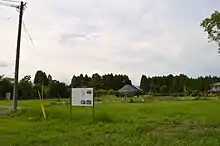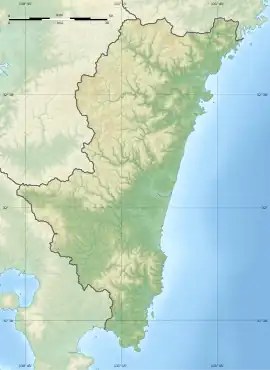日向国府跡 | |
 Hyūga Provincial Capital ruins | |
 Shimotsuke Provincial Capital ruins  Hyūga Provincial Capital (Japan) | |
| Location | Saito, Miyazaki, Japan |
|---|---|
| Region | Kyushu |
| Coordinates | 32°06′53″N 131°24′04″E / 32.11472°N 131.40111°E |
| History | |
| Periods | Nara - Heian period |
| Site notes | |
| Condition | 32°06′52″N 131°24′04″E |
| Public access | Yes |
The Hyūga Provincial Capital ruins (日向国府跡, Hyūga kokufu ato) is an archaeological site with the ruins of a Nara to Heian period government administrative complex located in what is now the Migimatsu neighborhood of the city of Saito, Miyazaki prefecture in the island of Kyushu, Japan. Identified as the ruins of the kokufu (provincial capital) of Hyūga Province, the site was protected by the national government as a National Historic Site since 2005.[1]
Overview
In the late Nara period, after the establishment of a centralized government under the Ritsuryō system, local rule over the provinces was standardized under a kokufu (provincial capital), and each province was divided into smaller administrative districts, known as (郡, gun, kōri), composed of 2–20 townships in 715 AD.[2] The kokufu complex contained the official residence and offices of the kokushi, the official sent from the central government as provincial governor, along with buildings housing offices concerned with general administration, farming, finance, police and military. In the periphery there was a provincial school (kokugaku), the garrison and storehouses for taxes.[3][4]
The Hyūga Kokufu ruins are located on a river terrace formed by the Hitotsuse River, almost in the center of Miyazaki Prefecture. There are many ruins scattered around the area, including the ruins of Hyūga Kokubun-ji provincial temple, Tsuma Shrine and the Saitobaru Kofun Cluster. There were various theories about the location of the Hyūga Kokufu, but excavations conducted from 1985 to 2000 by the Miyazaki Prefectural Board of Education at the Terasaki ruins, which was one of the most likely locations, confirmed parts of the foundations of a central building, including a side hall, and earthen palisades to the north, west and south, in the standardized "kokufu layout". Approximately one hectare of the center of the site was designated as a national historic site in 2005 due to its importance in considering the political situation of ancient Hyūga. The buildings were arranged with the main hall on the north side and side halls to the east and west in a "U" configuration.The main building was rebuilt from a dug-out pillar building to a cornerstone building. These buildings are thought to have been constructed between the end of the 8th century and reconstructed several times, the last of which was in the first half of the 10th century. The roof is presumed to have been tiled, and a large number of fragments of roof tiles and pottery have been unearthed, including items that show evidence of a government office, such as Kinai-style Haji ware pottery, inkstones, and pottery with ink inscriptions.[5]
The site is approximately 12 kilometers to the west of Hyūga-Shintomi Station on the JR Kyushu Nippō Main Line.
See also
References
- ↑ "日向国府跡". Cultural Heritage Online (in Japanese). Agency for Cultural Affairs. Retrieved 25 May 2020.
- ↑ Shively, Donald H.; McCullough, William H. (1999). Cambridge History of Japan vol. II (p.31f.). Cambridge University Press.
- ↑ Martin Schwind (1981). Das Japanische Inselreich (in German). Vol. Band 2: Kulturlandschaft, Wirtschaftsgroßmacht auf engem Raum. Berlin: de Gruyter. pp. 69–70. ISBN 3-11-008319-1.
- ↑ Atsuru Yagi (March 1986), "国府の成立と構造 -文献史料からみた-" [Formation and Structure of Kokufu (Provincial Capitals)], 国立歴史民俗博物館研究報告 [Bulletin of the National Museum of Japanese History] (PDF) (in Japanese), p. 343, ISSN 0286-7400, archived from the original (PDF) on 2013-10-29
- ↑ Isomura, Yukio; Sakai, Hideya (2012). (国指定史跡事典) National Historic Site Encyclopedia. 学生社. ISBN 4311750404.(in Japanese)
External links
- Saito city official home page (in Japanese)
- Miyazaki Cultural Heritage (in Japanese)